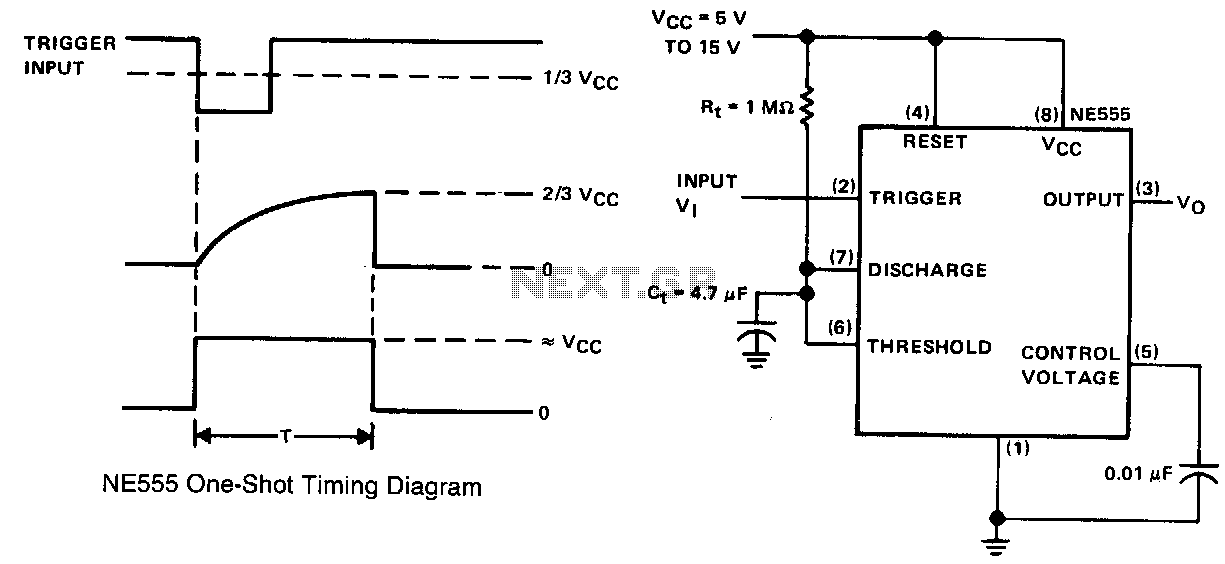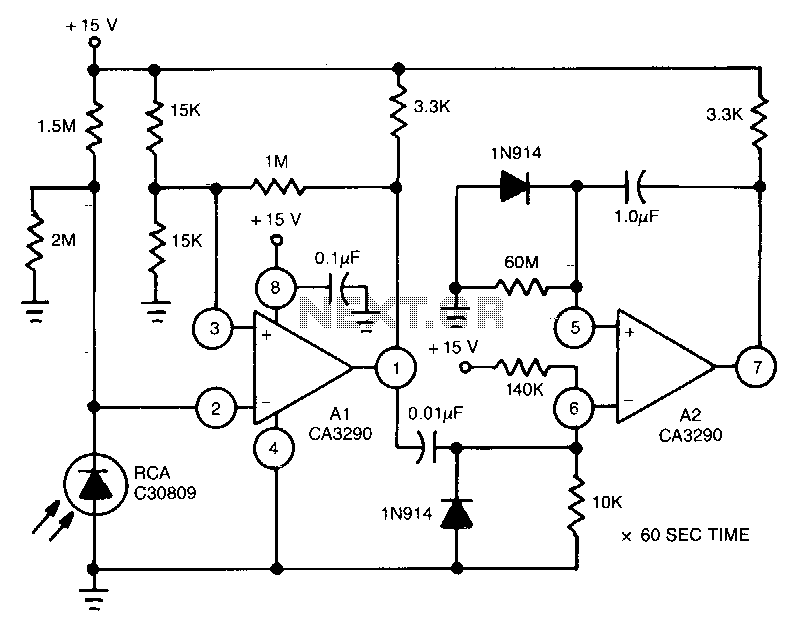
One-shot-timer

This simple circuit consists of only two timing components, Rr and Cr, the NE555 timer, and a bypass capacitor C2. Although C2 is not essential for operation, it is recommended for noise immunity. During standby, the trigger input terminal is held above 1/3 Vee, resulting in a low output. When a trigger pulse appears with a level below 1/3 Vcc, the timer is activated, initiating the timing cycle. The output then rises to a high level near Vcc, while Cr begins to charge towards Vcc. When the voltage across Cr exceeds 2/3 Vcc, the timing period concludes, and the output drops to zero, preparing the circuit for another input trigger. Due to the internal latching mechanism, the timer will always time out when triggered, regardless of any subsequent noise, such as bounce, on the trigger input. Consequently, the circuit can also function as a bounceless switch by employing a shorter RC time constant. A 100 kΩ resistor for Rr and a 1 µF capacitor for Cr would produce a clean 0.1-second output pulse when used as a bounceless switch.
This circuit utilizes the NE555 timer in monostable mode, where the timing components Rr (the resistor) and Cr (the capacitor) define the duration of the output pulse. The NE555 timer is a versatile and widely used integrated circuit that can generate precise timing and oscillation. In this configuration, the circuit remains in a stable low state until triggered by an input pulse.
The bypass capacitor C2, while not critical for the basic functionality of the circuit, plays a significant role in enhancing performance by filtering out high-frequency noise that could affect the operation of the timer. It is typically connected between the power supply pin and ground, ensuring stable voltage levels during operation.
The operation begins when the trigger input receives a pulse that momentarily drops below 1/3 of the supply voltage (Vcc). This causes the internal flip-flop of the NE555 to change state, driving the output high. The charging of Cr through Rr determines the length of time the output remains high. The time period (T) can be calculated using the formula T = 1.1 * Rr * Cr, where T is in seconds, Rr is in ohms, and Cr is in farads.
Once the voltage across Cr reaches 2/3 Vcc, the NE555 resets its output to low, completing the timing cycle. The internal mechanism ensures that any noise spikes or bouncing on the trigger line do not inadvertently retrigger the timer, making this circuit suitable for applications requiring reliable triggering, such as in switch debounce applications.
For bounceless switching, selecting Rr as 100 kΩ and Cr as 1 µF results in a timing duration of approximately 0.1 seconds, allowing for quick response times in applications such as push-button switches. This configuration effectively isolates the switch from noise, providing clean and reliable output signals.This simple circuit consists of only two timing components Rr and Cr, the NE555, and bypass capacitor C2. While not essentiaHor operation, C2 is recommended for noise immunity. During standby, the trigger input terminal is held higher than 1/3 Vee and the output is low. When a trigger pulse appears with a level less than 1/3 Vce, the timer is triggered and the timing cycle starts.
The output rises to a high level near Vcc. and at the same time, Crbegins to charge toward Vc·e· When the Crvoltage crosses 2 /3 Vco the timing period ends with the output falling to zero, and the circuit is ready for another input trigger. Because of the internal latching mechanism, the timer will always time out when triggered, regardless of any subsequent noise, such as bounce, on the trigger input.
For this reason, the circuit can also be used as a bounceless switch by using a shorter rc time constant. A 100-KO resistor for Rrand a 1-f."F capacitor for Cr would give a clean, 0.1 s output pulse when used as a bounceless switch.
This circuit utilizes the NE555 timer in monostable mode, where the timing components Rr (the resistor) and Cr (the capacitor) define the duration of the output pulse. The NE555 timer is a versatile and widely used integrated circuit that can generate precise timing and oscillation. In this configuration, the circuit remains in a stable low state until triggered by an input pulse.
The bypass capacitor C2, while not critical for the basic functionality of the circuit, plays a significant role in enhancing performance by filtering out high-frequency noise that could affect the operation of the timer. It is typically connected between the power supply pin and ground, ensuring stable voltage levels during operation.
The operation begins when the trigger input receives a pulse that momentarily drops below 1/3 of the supply voltage (Vcc). This causes the internal flip-flop of the NE555 to change state, driving the output high. The charging of Cr through Rr determines the length of time the output remains high. The time period (T) can be calculated using the formula T = 1.1 * Rr * Cr, where T is in seconds, Rr is in ohms, and Cr is in farads.
Once the voltage across Cr reaches 2/3 Vcc, the NE555 resets its output to low, completing the timing cycle. The internal mechanism ensures that any noise spikes or bouncing on the trigger line do not inadvertently retrigger the timer, making this circuit suitable for applications requiring reliable triggering, such as in switch debounce applications.
For bounceless switching, selecting Rr as 100 kΩ and Cr as 1 µF results in a timing duration of approximately 0.1 seconds, allowing for quick response times in applications such as push-button switches. This configuration effectively isolates the switch from noise, providing clean and reliable output signals.This simple circuit consists of only two timing components Rr and Cr, the NE555, and bypass capacitor C2. While not essentiaHor operation, C2 is recommended for noise immunity. During standby, the trigger input terminal is held higher than 1/3 Vee and the output is low. When a trigger pulse appears with a level less than 1/3 Vce, the timer is triggered and the timing cycle starts.
The output rises to a high level near Vcc. and at the same time, Crbegins to charge toward Vc·e· When the Crvoltage crosses 2 /3 Vco the timing period ends with the output falling to zero, and the circuit is ready for another input trigger. Because of the internal latching mechanism, the timer will always time out when triggered, regardless of any subsequent noise, such as bounce, on the trigger input.
For this reason, the circuit can also be used as a bounceless switch by using a shorter rc time constant. A 100-KO resistor for Rrand a 1-f."F capacitor for Cr would give a clean, 0.1 s output pulse when used as a bounceless switch.
